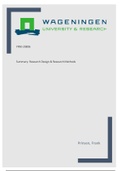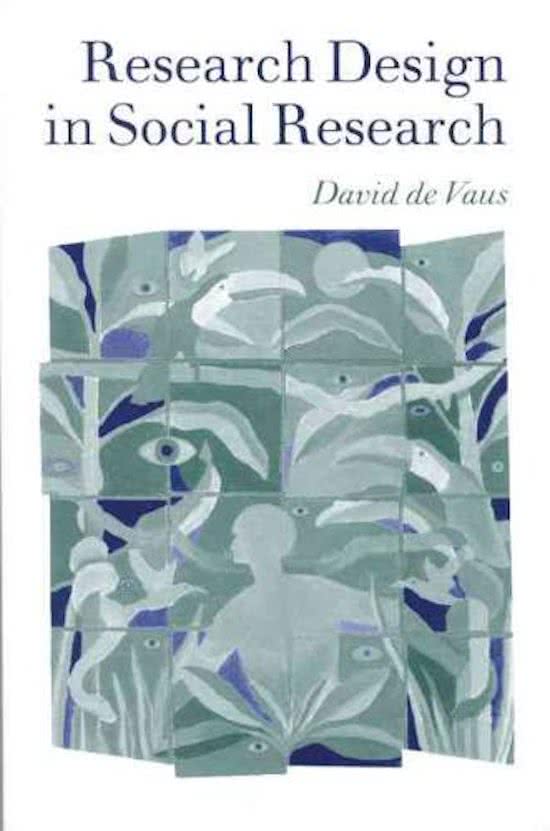YRM-20806
Summary: Research Design & Research Methods
Prinsen, Frank
1
,Chapter 1 What is Research Design:
The context of design:
✓ Scientific research is:
▪ Objective: unbiased, non-normative (should present facts, not norms)
▪ Systematic: measurement reliable and valid.
▪ Theoretical: undertaken in framework with existing theories, cumulative.
✓ Data types:
▪ Primary data: self-collected (through experiment)
▪ Secondary data: other researchers’ primary data (desk research)
✓ Empirical vs. non-empircal:
▪ Empirical: knowledge acquired through observation (water → gravity)
▪ Non-empirical: knowledge based on logic or definition (Einstein → gravitational
waves)
✓ Quantitative research:
▪ Measurement by assigning numbers to a limited set of variables
▪ Identifying general patterns that apply to many objects (reductionist approach)
▪ E.g. what is your opinion about fair trade? VNegative 1 2 3 4 5 VPositive
✓ Qualitative research:
▪ Measurement in terms of words
▪ Identifying unique patterns in only a few objects (holistic approach)
▪ E.g. what is your opinion about fair trade?
✓ Applied research or practice-oriented research:
▪ Gain knowledge to help sole a practical problem (Important)
▪ E.g. fuel-wood use and deforestation in Africa
✓ Fundamental research or theory-oriented research:
▪ Gain knowledge to improve or expand existing knowledge about a specific
phenomenon
▪ E.g. identification of dimensions constituting disaster experiences
• Two fundamental types of research questions:
1. Description: What is going on?
o E.g. covers much government sponsored research (e.g. population growth)
o Questions e.g.: is the level of social inequality increasing or declining?, How much
poverty is there in this community?
o Good description provokes the ‘why’ questions of explanatory research.
o The focus, facts and dimensions of the ‘problem’ should be clearly set before doing
research. Otherwise, research will be performed on a potential ‘non-existence
problem’.
2. Explanation: Why is it going on?
o Primarily covers why questions and answer the cause of the problem questions
stated as a descriptive problem. (the crime rate has risen over the years, BUT why
did it rise?
o Answering the ‘why’ questions involves developing causal explanations.
o Causal explanations argue that phenomenon Y (income level) if affected by factor X
(gender)
o More complex causal explanations e.g. there is a direct effect of gender on income
o Therefore, different causal models can be used for the explanations:
▪ Direct causal relationship; Gender → income
▪ Indirect causal relationship; Gender → …. → …. → …. → income level
2
, ▪ Complex direct and indirect causal relationship;
• Prediction, correlation and causation
o Correlational is not directly causation. It could be coincidence rather than
causational
o Examples:
▪ Correlation between the number of fire engines at a fire and the amount of
damage caused by the fire (the more fire engines the more damage).
Conclusion; number of fire engines causes the amount of damage? →
clearly the number of fire engines and the amount of damage will both be
due to some third factor (e.g. fire intensity).
▪ The divorce rate changed over the twentieth century the crime rate
increased a few years later. → this does not mean that divorce causes
crime. Rather than divorce causing crime, divorce and crime rates might
both be due to other social processes such as greater poverty
o Where two event or characteristics are correlated we can predict one from the
other
o Good prediction does not depend on causal relationships. Nor does the ability to
predict accurately demonstrate anything about causality.
o Correlation can be observed. Nevertheless, causation cannot be observed.
o It should be minimised saying that the chances of incorrectly saying that a
relationship is causal when in fact it is not.
o Invalid inferences should be avoided in explanatory research!!!
• Deterministic and probalistic concepts of causation:
o Two ways of thinking about causes:
1) Deterministically:
▪ Where variable X is said to cause Y if, and only if, X Invariably
produces Y. That is when X is present then Y will ‘necessarily,
inevitably, and infallibly’ occur. (when X is there Y will 100% be
as a result)
▪ E.g.: when a smoker denies that tobacco causes cancer because
he smokes heavily but has not contracted cancer.
▪ This approach seeks to establish causal laws: Facts
3
, ▪ But those laws (facts) should be specified to exclude any
potential influencing factors (e.g. at sea level heating pure water
to 100Co will always boil)
2) Probabilistically:
▪ Most causal thinking in the social sciences is probabilistic
rather than deterministic.
▪ E.g.: illustrated by health authorities who point to the increased
chances of cancer among smokers.
o That is, we work at the level that a given factor increases (or decreases) the
probability of a particular outcome.
o Probabilistic explanations can be improved by specifying conditions under which X is
less likely OR more likely to affect Y.
o Due to the fact that behaviour is not simply determined we cannot achieve
deterministic explanations. BUT we can achieve probabilistic explanations; e.g. a
given factor will increase the likelihood of a given outcome but there will never the
certainty about outcomes.
• Theory testing and theory construction
o The empirical cycle: Research phases
▪ phases:
▪ Theory building:
▪ Observation
▪ Induction (Cause)
▪ Theory testing:
▪ Deduction (Hypothesis)
▪ Testing of hypotheses
▪ Evaluation
o Theory building (explained):
▪ Is the process in which research begins with observations and uses inductive
reasoning to derive a theory from these observations.
4
, ▪ This form entails asking whether the observation is a particular case of a
more general factor, or how the observations fits into a pattern or a story
o Theory testing (explained):
▪ In contrary to building, it begins with a theory and uses theory to guide
which observations to make: it moves from general to particular.
▪ Should provide a test of the worthiness of the theory (an experiment)
▪ Using deductive reasoning to derive a set of propositions from the theory
does this. (making hypothesis)
▪ Types of hypothesis:
➢ Non-relational: expectation about one concept (variable)!
o Y is…
o E.g. >30% of car drivers on the A12 is speeding
➢ Correlational: states relation between concepts (variables)
o Relation between X and Y
o E.g. speeding is related to region
➢ Developmental: states development of one or more
concepts (variables) over time
o Y changes with time
o E.g. speeding has decreased in the last decade
➢ Causal: States causal relation between concepts (variables)
o X causes Y
o E.g. speeding leads to higher number of road
accidents.
▪ Correlational, developmental, causal hypothesis can be further refined
into:
➢ Directional hypothesis: states the direction
o As X increases, Y increases/decreases
o E.g. as age goes up speeding becomes less
➢ Non-directional hypothesis: does not state direction
o As X changes, Y changes
o E.g. age and speeding are related.
▪ If the predictions are correct the theory is supported. If not, theory should
be rejected or modified.
5
,• What is research design?
o Social research needs a design or a structure before data collection or analysis can
be performed.
o A research design is not just a work plan!!!
o It details what has to be done to complete the project, but the work plan will be
derived from the project’s research design.
o Function: to ensure that the evidence obtained enables us to answer the initial
question as unambiguously as possible (as correct as possible).
o When designing we need to ask: given this research question, what type of evidence
is needed to answer the question in a convincing way.!! (or theory)
o Design versus method:
▪ Data for any design can be collected with any data collection method. How the
data are collected is irrelevant to the logic of the design!
▪ By choosing cross-sectional designs with e.g questionnaires or case studies with
participant observation, means that the outcome is often not a unambiguous
conclusion.
6
, o Quantitative and qualitative research:
▪ Information to prove the theory should be found as; we should be sceptical
on the information which supports the evidence or theory but rather
seeking evidence that provides a compelling test of the theory!!
o Plausible rival hypotheses:
▪ Social research involves evaluating plausible rival hypotheses.
▪ It is needed to examine and evaluate alternative ways of explaining a
particular phenomenon. (REGARDLESS: qualitative, quantitative data;
research design (experiment, cross sectional, case study, etc.) and the
method of data collection)
▪ The mindset needs to; anticipate alternative ways of interpreting findings
and to regard any interpretation of
these finding as a subject to further
testing (do not assume data is 100%
correct)
7






